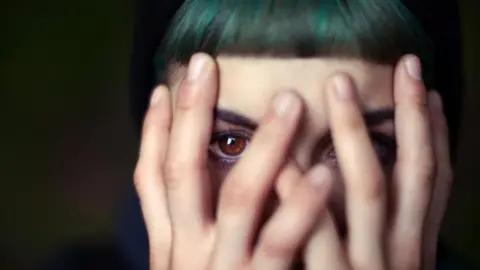Misokinesia: The condition that makes people hate fidgeting

 Getty Images
Getty Images“If I see someone tapping their fingers on a desk, my immediate thought is to chop their fingers off with a knife,” an anonymous patient confides to a researcher.
Another shares: “When I see someone making really small repetitive movements, such as my husband bending his toes, I feel physically ill. I hold it back but I want to vomit.”
Sound familiar? If so, perhaps you too have a condition called misokinesia – a diagnosable hatred of fidgeting.
Scientists are striving to understand more about the phenomenon that has no known cause, as yet.
 Getty Images
Getty ImagesFor the latest research, featured in the journal PLoS One, experts carried out indepth interviews with 21 people belonging to a misokinesia support group.
Common triggers were leg, hand or foot movements – jiggling thighs, twitchy fingers and shuffling shoes.
Pen clicking and hair twiddling were also triggers, though not quite as frequently.
Often people reported some overlap with another more recognised condition called misophonia – an intense dislike of other people’s noises, such as heavy breathing or loud eating.
It’s impossible to know exactly how many people might be experiencing misokinesia. One recent Canadian study suggested perhaps one in three of us might be adversely affected by other people fidgeting, experiencing intense feelings of rage, torture and disgust.
I spoke with Dr Jane Gregory, a clinical psychologist at Oxford University in the UK, who has been studying and treating both misokinesia and misophonia.
She told BBC News: “The two go alongside each other very frequently. Often people have both at the same time.”
Although there is no good data, Dr Gregory says the conditions are probably suprisingly common.
“Obviously, people have been experiencing it for a long time but just didn’t have a name for it.”
The severity of people’s aversion to fidgeting varies, she tells me.
“Some people might get really annoyed by fidgeting or repetitive movements but it doesn’t impact massively on day-to-day life,” she says.
Others, however, may “get a really strong emotional reaction – anger, panic or distress – and just can’t filter them out”.
Through Dr Gregory’s work, she tends to meet people with more extreme symptoms. Many are adults who have endured misokinesia for years, but some are in their early teens and experiencing it for the first time.
‘It just explodes inside you’
 Supplied
SuppliedAndrea, 62 and from the UK, says she developed misophonia and misokinesia at 13 but that it wasn’t recognised at the time.
One of her earliest memories of the condition is being distressed by a girl at school who was picking her nails.
“Most of misokinesia tends to focus around people’s hands – what they are doing with their hands and what they are touching,” she says.
Another trigger for her is when people partially cover their mouth with their hand while speaking – she struggles to watch and feels like her own mouth is becoming sore when she does.
Andrea says the anger she experiences is explosive and instantaneous.
“There’s no thought process in it. There’s no rationale. It just explodes inside you, which is why it is so distressing.”
She tells me she has tried different strategies to manage her condition, but can’t block it out.
Now she shields herself from society, living alone and working from home, and says her whole life is designed around avoiding the things that could distress her.
Andrea says she has lots of supportive friends who understand that she sometimes needs to modify how she interacts with them.
“It’s easier to just withdraw. To try and survive it. You can’t keep asking other people not to do things.”
She explains that she doesn’t blame people for their fidgeting and understands that most people’s actions are unintentional and done out of habit.
Andrea says sharing her experiences with a Facebook support group has been a real help.
‘I get so much anger’
 Supplied
SuppliedJill, who is 53 and from Kent, is another member of that group.
She says her misokinesia makes her heart race.
“Anything can trigger me, from leg bouncing to how someone looks and holds their fork.
“I get anger, so much anger.
“My heart starts beating too fast. It’s like a fight for flight.”
Ball of anxiety
Julie, who is 54 and from Hull, says the main feeling she experiences with her misokinesia is angst.
“The other day, I was on the bus and there was a lady walking by and both her arms were swinging. I couldn’t take my eyes off it. I was getting really anxious with it, not angry.
“It’s silly things like someone is making me a cup of tea and they get the teabag and bounce it up and down, up and down, up and down. Why?
 Supplied
Supplied“Or if someone is sat there wobbling their leg. I can’t take my eyes off it. Or if I do look away, I have to look back to see if they are still doing it.”
She tells the BBC the unpleasant feeling afterwards can eat away at her for hours.
“I’m not an angry person. It just makes me feel like there is a ball in my stomach that wants to explode. It’s not anger, it’s feeling really anxious inside.”
Julie says she is not afraid to ask people to stop doing something that she is finding distressing, but tends to walk away instead.
Her misokinesia makes her unhappy, she tells me.
“It makes me internalise it. I don’t like myself for feeling like this.”
Hypervigilant inner meerkat
Dr Gregory says the condition can be extremely debilitating and prevent people from focusing and doing normal things.
“Part of their brain is constantly thinking about this movement,” she explains.
“Violent images might pop into their head. They want to grab the person and force them to stop… even though they are not angry in their normal lives.”
In terms of why some people are triggered, Dr Gregory says it might be a heightened basic survival instinct – like a meerkat on the lookout for danger.
 Getty Images
Getty ImagesShe likens the feeling to seeing “someone scurrying in the distance” or “tuning into footsteps behind you”.
“For some people, you don’t tune it out again. Your brain is continually monitoring.”
In noisy, hectic modern life, it’s not very useful, she says.
And if you keep getting triggered, the frustration and anger can build.
For some people, it’s strangers’ habits that are most irksome, while for others, it’s loved ones.
One common way people try to manage the condition is by avoiding looking at fidgeting or by distracting themselves, Dr Gregory says.
Others may try to avoid people entirely, as much as they can.
If there is only one isolated visual trigger – such as hair twirling – the expert says it is sometimes possible to use reframing therapy to help the person view the situation in a more positive way.
“You might look at it deliberately and create a new backstory for why someone is doing that movement.”
That can help reduce the anger and anxiety, she says.
“A lot of people feel really embarrased or ashamed that they get such strong reactions,” Dr Gregory adds.
“That, itself, can be a problem because suppressing your emotions can intensify them and make them worse.”



